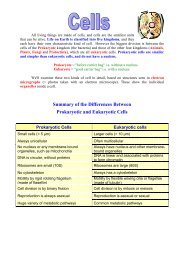Continuous and discontinuous variation - BiologyMad A-Level Biology
Continuous and discontinuous variation - BiologyMad A-Level Biology
Continuous and discontinuous variation - BiologyMad A-Level Biology
You also want an ePaper? Increase the reach of your titles
YUMPU automatically turns print PDFs into web optimized ePapers that Google loves.
•<br />
•<br />
•<br />
•<br />
•<br />
Hardy – Weinberg<br />
This principle states that the proportion of the different alleles in a gene<br />
pool (breeding population) only changes as a result of an external factor.<br />
Thus providing the following assumptions are met, each generation will<br />
be the same as the present one:<br />
Large population<br />
No migration – either in (immigration) or out (emigration)<br />
There is r<strong>and</strong>om mating<br />
No mutations occur<br />
All genotypes are equally fertile<br />
Worked Example:<br />
In a population containing 2 alleles, T <strong>and</strong> t, three genotypes<br />
will exist – TT, Tt <strong>and</strong> tt. If T is a dominant allele, then it is<br />
impossible to tell which individuals are Tt <strong>and</strong> which are Tt. It<br />
will also be impossible to tell the relative proportions of these<br />
two genotypes. The Hardy-Weinberg equation allows us to<br />
calculate that.<br />
Stages in the calculation:<br />
Let the proportion of T alleles = p <strong>and</strong> the proportion of t alleles<br />
= q. Then:<br />
p + q = 1<br />
Both p <strong>and</strong> q are decimal fractions, <strong>and</strong> therefore both will be<br />
less than 1.0.<br />
That means that the proportion of the different genotypes is:<br />
TT individuals are p 2 ;<br />
Tt individuals are 2 pq; <strong>and</strong><br />
Tt individuals are q 2<br />
Since that is the whole population, it follows that:<br />
1 = p 2 + 2pq + q 2<br />
Now, we can see, <strong>and</strong> count, those individuals that are tt<br />
(double recessive), so:<br />
1. Work out the proportion (as a decimal fraction, i.e.<br />
5% = 0.05) of tt individuals in the whole population.<br />
The question will give you this data, so just use your<br />
calculator!<br />
2. Take the square root of that number. That gives you q<br />
3. Since p + q = 1, you can now calculate p (it is 1 − q).<br />
4. Substitute the values you now have in the equation 1 =<br />
p 2 + 2pq + q 2 to give you the decimal fraction of each<br />
of the genotypes.<br />
5. If the question asks you to calculate ‘how many individuals in then population are….’,<br />
then multiply the number you have (for the required genotype) by the total population.<br />
Remember that you cannot have a fraction of an individual, so round up/down to the<br />
nearest whole number.<br />
6. Easy, isn’t it!
















